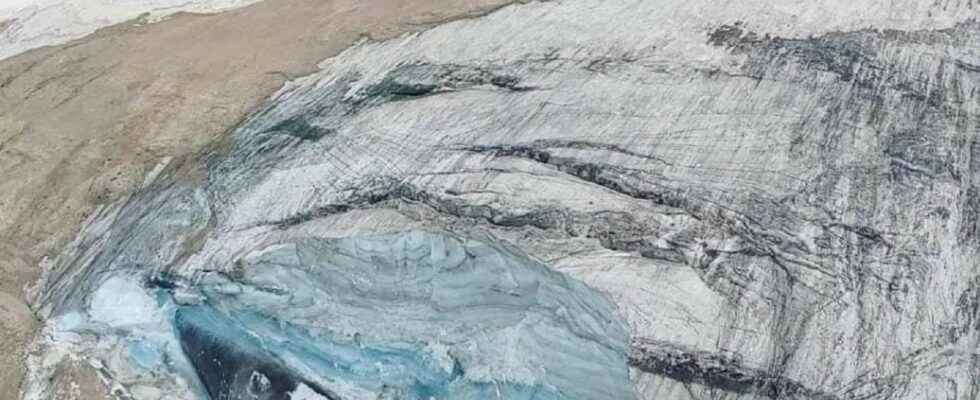You will also be interested
[EN VIDÉO] COP21: Mont-Blanc glaciers threatened by global warming Satellites have enabled glaciologists to observe a record thinning of 12 meters per year in the glaciers of the Mont-Blanc massif in their lowest part. The Cnes offers us a video update on this worrying situation.
The one who is nicknamed “the queen of the Dolomites”, the Marmolada Glacier, culminates at 3,343 meters in the Italian Alps. It is the highest mountain in the Dolomites, which is located about 170 kilometers from Venice. It is one of the most popular hiking areas in Italy, especially at this time of year, before the heavy heat of high summer. This Sunday, while two teams of hikers were traveling well-known paths in the area, a huge block of ice from Punta Rocca, one of the peaks of the massif, broke off before descending to a speed estimated at nearly 300 km/h. The block of ice split into two parts and thecollapse pieces spread over about 300 meters. The balance sheet, not definitive, is heavy, at least six dead, eight injured and a dozen missing.
Marmolada 3343m
Tremendo accidente acaba de pasar in Marmolada, Dolomitas.
A huge serac was released by the high temperatures, cayendo over the normal route of ascent.
6 dead and 10 disabled. Búsqueda con helicópteros y rescate en marche ahora????Nicoletta Barbessi pic.twitter.com/p3iL2H2DA0
— k2 (@KrisAnnapurna) July 3, 2022
A heat record recorded the day before
The Dolomites region has been facing exceptionally high temperatures for several weeks. Moreover, the area is in a state of drought severe since spring with numerous fires during the month of June.
A heat record was recorded the day before the glacier collapsed: 10°C at the top of the Marmolada, the highest temperature recorded since the start of the records weather report on the area. At this altitude, even in the middle of summer, the temperature should not exceed 0°C. A few days before, an exceptional temperature of 24°C had been recorded in the same area at 2,000 meters above sea level. Such heat has the effect of weakening the glacier, and sometimes, of letting water pass under the ice, which can trigger a collapse. The weather conditions are particularly mild and dry in this region of Italy, and the few rare precipitations that have fallen in recent weeks have been rain, and not snow, including at high altitudes.
The footage of the large ice avalanche in Marmolada today in close proximity.
We don’t know the author, we will write it in the comments as soon as we will know it.
Indeed an impressive sequence pic.twitter.com/zDo4q40qOP
— Alpine-Adriatic Meteorological Society (@aametsoc) July 3, 2022
An observation that applies to all of the Northern Alps: in Italy, Austria and France in particular. let’s remember that the summit of Mont-Blanc also broke a temperature record on June 18, with 10.4°C. On the Austrian side, Mount Sonnblick, which culminates at 3,105 meters, undergoes a melting record snowfall. All the snow has already melted in early July, when it never melted earlier than August 13 (in 2003).
The Marmolada glacier will disappear within 30 years
Despite these abnormally high temperatures in the Dolomite range, no restriction measures had apparently been put in place for hikers. According to Jacopo GabrieliItalian researcher in polar sciences at the CNR“ it is impossible to predict when the serac of a glacier may break up”. The Italian organization estimates that the Marmolada glacier will have disappeared within 25 to 30 years. Italy has also been described as ” climate change hotspot” by the UNjust like the Mediterranean basin in France.
According to French CNRS experts“ the observed retreat of glaciers for several decades is attributable, with a high level of confidence, to global warming. Whatever the climate scenario, the glaciers will continue to melt until 2050. The rest will depend on our greenhouse gas emissions ».
Incredible footage from an helicopter of the mountain rescue of the basal detachment in Marmolada.
Water lubrication at the base (or interstrata) and increased pressure in water-filled crevasses are probably the main causes for this catastrophic event pic.twitter.com/2OXRExkdjy
— Alpine-Adriatic Meteorological Society (@aametsoc) July 3, 2022
Reading ideas for the summer with Futura?
To celebrate the start of the holidays, we offer you the Mag Futura at the preferential price of 15 € instead of 19 €, i.e. a reduction of 20% !
What is Mag Futura?
- Our first paper journal of more than 200 pages to make science accessible to as many people as possible
- 4 major scientific questions for 2022, from the Earth to the Moon
- Home delivery*
*Special offer valid until July 19. Delivery is made in France (excluding metropolitan France), Switzerland, Belgium.
Interested in what you just read?
